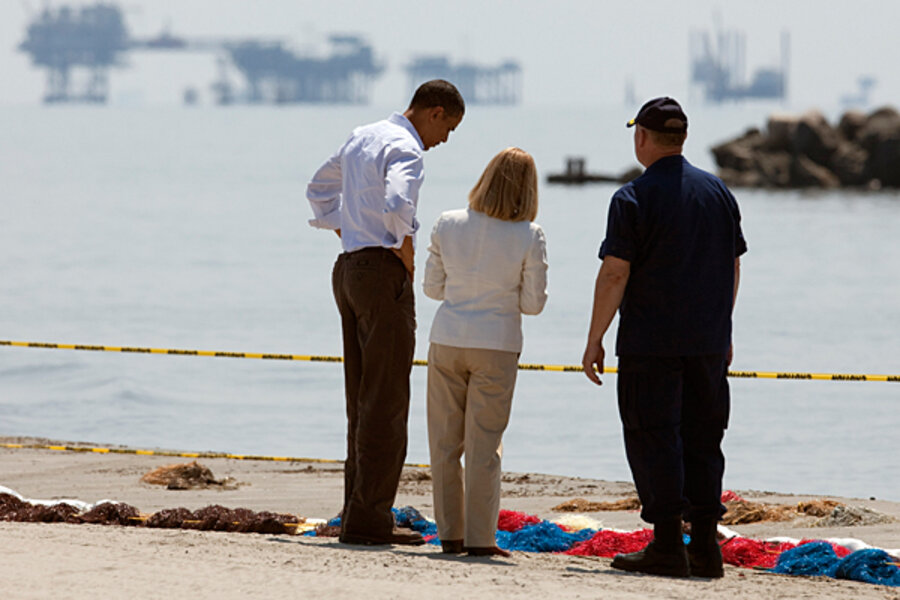'Top kill' to stop Gulf oil spill in 'very critical' stage: US official
Loading...
With the "top kill" timeline stretching on amid what one US official calls a "very critical" period, President Obama said Friday he will send reinforcements to the Gulf Coast within 24 hours to help deal with the massive BP oil spill.
His plan calls for tripling the manpower in places where oil has already hit shore or is expected to arrive within 24 hours. The president, in Louisiana for an update on containment and cleanup efforts, says the added manpower will help corral the spill more quickly and minimize the amount of time oil is on the coastline.
Regarding the top kill procedure, which is aimed at staunching the flow of crude oil from the Deepwater Horizon well 50 miles off the Louisiana coast, Coast Guard Adm. Thad Allen struck a more cautious note Friday than he had previously on the headway oil giant BP is making.
After Allen said Thursday that the operation had squeezed the runaway flow of oil, BP acknowledged that on Wednesday night engineers had stopped the flow of drilling mud meant to cork the well. Their concern was a buildup of pressures in the blowout preventer on the ocean floor, which is the piece of equipment that attaches the live well to a crumpled "riser" pipe left after the Deepwater Horizon rig exploded and sank on April 22, killing 11 workers.
Pumping began again on Thursday evening, then stopped again 10 hours later. It was not clear Friday afternoon whether the drilling mud was flowing again. Allen, who is overseeing the response effort for the government, said on ABC's "Good Morning America" Friday that the next 12 to 18 hours are "very critical" as BP attempts to build up enough mud to be able to ease up the pumping in order to backfill the well with a concrete cap. The concern is that the well could simply blow again, potentially shooting out more oil than before.
BP executive Tony Hayward said early Friday that it will be as many as 48 hours before results are known. According to BP's Andrew Gowers, the top kill is by nature a stop-start process, in which engineers pull back the pressure to make readings and gauge their next move, The New York Times reported Friday.
A top kill has never been tried 5,000 feet below sea level, where the pressure is 150 times that of the Earth's atmosphere. A small team of ROV submarines is doing the hands-on work at the bottom, attached to a small fleet of ships and barges on the surface.
On Friday, BP's Mr. Hayward reiterated that the likelihood of success is 60 to 70 percent.
Some past attempts to use top kills on blown-out underwater wells, including on the 1979 Ixtoc 1 blowout off Mexico's Gulf Coast, have failed, forcing companies to the final backup plan: drilling a relief well, which can take months. As with the top kill, drilling a relief well is an intricate procedure. A relief well is a separate drilling hole aimed to tap directly into the spewing well to capture escaping oil. It's a surgical operation and entails using a drill bit to pierce a foot-wide pipe beneath thousands of feet of bedrock.
BP is already drilling two relief wells, the first of which would not be ready until August. If the top kill fails, the company will try again try to put a cofferdam over the well to collect the oil. A similar plan failed earlier this month when methane crystals built up, clogging the contraption. Another option is to place a working blowout preventer on top of the malfunctioned one. Both those methods are risky because they will require technicians to cut away part of the pipe that leads to the failed blowout preventer, which could release a larger plume of oil.
The stakes on the top kill effort rose as the disaster, by most accounts, surpassed that of the 1989 Exxon Valdez spill in Alaska. Every day that the well is still live and oil hits the shore, the political toll rises on President Obama, who is in the midst of coping with his first major disaster.
Mr. Obama's Thursday press conference, where he reiterated that "[spill response] has been our highest priority," lacked enough anecdotes or details about the government's efforts to be effective, says Charles Franklin, a pollster and a political scientist at the University of Wisconsin, in Madison.
While the Obama administration pushed BP to continue its live camera feed from the well site during the top kill procedure, it also "should be making sure there are television crews on the Coast Guard boats and in the BP command center," in order to counteract a spreading belief that the government is failing, says Mr. Franklin. According to a CBS News poll this week, 45 percent of Americans disapprove of Obama's handling of the spill, and 70 percent disapprove of BP's response.
"I'm stunned that it took the White House this long to have a press conference and stunned at how poorly the press conference went," says Franklin. "There are clear ways the White House could be communicating better about their efforts."
But much more than Obama's political status is at stake in the top kill gambit, namely the livelihoods of thousands of people who depend on the sea and the lives and health of wildlife and habitat. Cleanup is a pressing concern, and regulatory reform and lawsuits are also under way – though attention is riveted for now on the top kill.
"It's hard to overstate how important killing the well is, because nothing can go forward until they've stopped the flow of oil," says Robert Bryce, author of "Power Hungry."
Associated Press material was used in this report.
Related:





